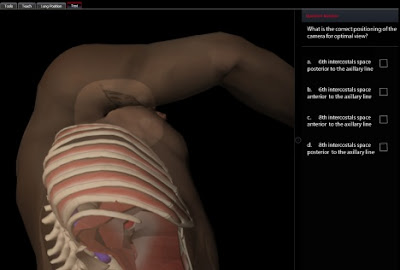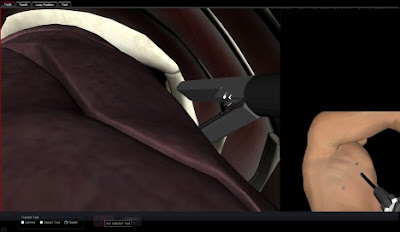Surgical training simulators provide residents with a highly realistic and safe approach for learning complicated surgical procedures. As surgeries become more technically advanced, and rely on video-assisted surgical procedures, the training for these types of surgeries needs to become more advanced as well. Surgical training simulations allow students to preform virtual operations as many times as necessary until mastery is achieved, without ever putting an actual patient at risk.
This summer NYU Langone Medical Center, in partnership with BioDigital, created a touch-enabled medical training simulation to teach the skills that are necessary to preform a video-assisted thoracoscopic surgery lobectomy. The Right Upper Lobe Resection Cognitive Task Trainer allows surgical trainees to interact with the software through the use of a haptic device. Delivering vibration and resistance forces to the user, haptic technology allows surgeons to feel the anatomy of a simulated patient just as they would a live patient.

Right Upper Lobe Resection Cognitive Task Trainer
Over the past 10 years video-assisted thoracoscopic surgery lobectomy operations have replaced more traditional open lung surgeries. With the limited visibility available to surgeons during video-assisted surgery, training for this type of procedure has become increasingly difficult and complicated. Traditional cadaver training is possible for this type of procedure, but is an expensive option since cadaver organs can only be used once. Simulators remove this expense and allow trainees to practice a procedure repeatedly until they have mastered it.

Video-Assisted Thoracoscopic Surgery Lobectomy Training Simulator
The Right Upper Lobe Resection Cognitive Task Trainer teaches residents to identify important physical structures like the right pulmonary artery, superior and inferior pulmonary veins, and the right pulmonary ligament. Students are able to learn and practices proper placement of the camera port, dissector port, and stapler port in safe and cost-effective environment.
Simbionix is another company that develops medical training simulators and clinical devices for minimally invasive surgical operations. Medical training simulators offer clinicians a virtual hands-on experience without putting patients at risk. Medical professionals are able to practice their existing skills and learn new procedures quickly and effectively, essential elements of ensuring quality outcomes in real-world medical procedures.
Simbionix Suturing Training Simulator
Since surgical training simulators are computer-based, they can act as both a training tool and an assessment device. Trainees are able to learn all of the skills necessary to master their craft and become proficient at a variety of procedures, while trainers are able to evaluate their performance based on a quantifiable metric of competence. The bottom line is that surgical simulators increase clinical proficiency and decrease medical errors and costs.
